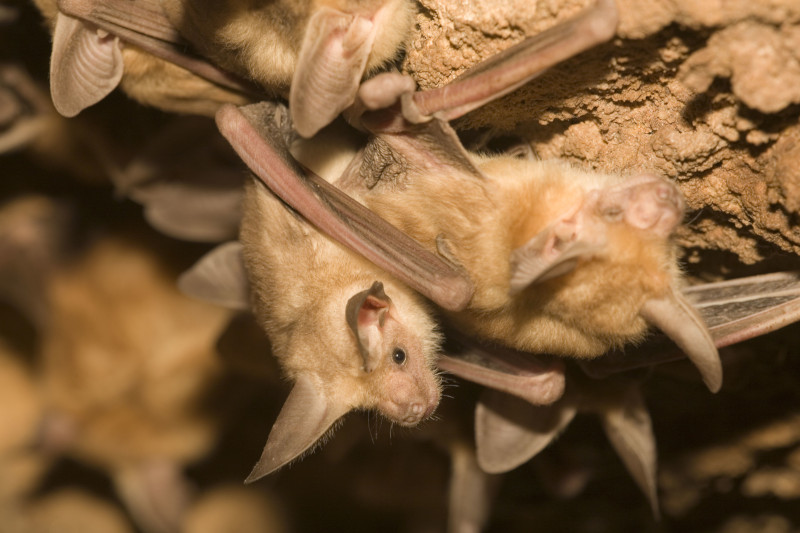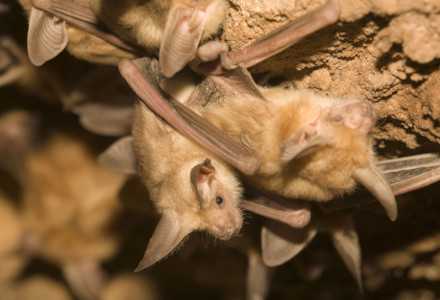
Pallid Bat Facts
- Firstly, the distinctive term Pallid Bat serves as the common name for the species of bat with the bulky scientific name of Antrozous pallidus. Secondly, this surprising creature also holds a moderate claim to fame, at least in scientific circles.
- That holds true due to a claim that very few species can make. That remains the fact that the mammal also presently remains the only species within its genus. It also bears a close relationship with another variety of bat, the Van Gelder’s bat.
- This amazing species also distinguishes itself from other bats in yet another, more important manner. That’s due to a rather startling evolutionary divergence. Quite amazingly, it does not always employ echolocation to locate its food.
- Although it does certainly have and use this ability, it also sometimes hunts in a different fashion. In this instance, though, the animal uses its large ears to locate its food. In this case, it employs them to locate prey, usually insects, on the ground.
- Most fortunately, the fascinating Pallid Bat appears to continue to be relatively abundant throughout the entirety of its natural range. Due to this, the IUCN currently lists the animal as Least Concern on its Red List of Threatened Species.
- The remarkable creature nevertheless still faces several potential concerns regarding its future. That’s because, like many species, it faces the danger of habitat loss. It also, however, must now deal with the threat of climate change.
Related Articles
Pallid Bat Physical Description
Despite its other unique and distinctive characteristics, the fascinating Pallid Bat nevertheless remains a physical modest-sized species. But, it does remain unlike the vast majority of the other types of bats in the world in one particular regard.
That holds true because the fascinating species displays no noticeable degree of the trait of sexual dimorphism. As a result of the lack of this genetic trait, mature adults of both genders attain roughly the same average head-and-body length.
More precisely, this equals a measurement of about 2.4 – 3.35 in (6.0 – 8.5 cm). The over-sized tail may additionally account for 1.4 – 2.25 in (3.5 – 5.7 cm) of this length. This type of bat also achieves an average wingspan measuring roughly 15 – 16 in (38 – 40 cm).
This remarkable animal further develops a somewhat distinctive fur. To be more precise, this fur reportedly has a feel akin to that of soft wool. This fascinating pelage almost exclusively presents a highly uncommon two-tone color pattern.
That’s due to the fact that it appears as light brown to a cream color on the upper side of the small body. Meanwhile, the rest of the body diverges from this. In a moderately sharp contrast, the Pallid Bat presents a decidedly pale white color on the under side.
- Kingdom: Animalia
- Phylum: Chordata
- Class: Mammalia
- Order: Chiroptera
- Family: Vespertilionidae
- Genus: Antrozous
- Species: A. pallidus
Pallid Bat Distribution, Habitat, and Ecology
Most notably, the remarkable Pallid Bat inhabits a quite extensive habitat range compared to other varieties of bats. To the great surprise of many people, the truly remarkable small mammal appears throughout a large portion of the continent of North America.
More precisely, this bat lives in areas extending from British Columbia, in Canada, through the western United States, and as far as central Mexico. Also, for currently unknown reasons, one small population of the creature also currently resides in Cuba.
Regardless of its exact geographical location, however, the impressive mammal displays a marked preference for a specific habitat type. That consists mainly of desert or at least semi-arid regions within its native range. This is a trait shared by many related species.
Although it roosts opportunistically, it most frequently prefers stony outcroppings. But it will also opportunistically roost in regions such as pine and oak forests, and even farmland. It also often has two roosts, one for day use and one for the night.
In another deviation from the patterns displayed by most bats, it does not mainly consume flying insects. It typically hunts its prey on the ground. Although it will take virtually any arthropod it finds, this typically consists of crickets, but sometimes even includes scorpions.
As a result, the diet of individual specimens of Pallid Bat varies somewhat. This occurs because it principally consumes various locally prevalent arthropods. In fact, this insectivore often consumes as much as half its body weight in prey every night.
Species Sharing Its Range
Check out our other articles on Astounding Lizards of the World, Japanese Angelshark, Thorsmork, Jackfruit Tree, Lord Howe Island Stick Insect, Panda Dolphin, Greater Sage Grouse

